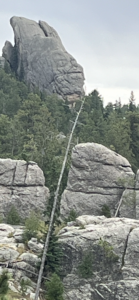 Do you know what pareidolia is?
Do you know what pareidolia is?
Until recently, I’d never even heard the word, let alone known that it’s a psychological condition I probably have. Pareidolia is the tendency to perceive meaningful images in random visual patterns. Seeing the Virgin Mary on a piece of buttered toast, for instance. Or Sasquatch in the bark of a tree trunk. Or Puff the Magic Dragon up in the clouds.
I’ve never seen any of those things, but I do spot faces in strange places. I peeled the cellophane off my yogurt cup not long ago and saw a funny face staring back at me. Someone using a Sharpie drew a smiley face on the purse hook in a bathroom stall at Walmart, a discovery so delightful and unexpected—though impossible NOT to spot—that I took a picture of it to show my friends. And I see a man’s face—eyes, nose and mouth–every time the moon is full.
Mostly, though, the faces and shapes I spot are in rocks. One reason I went to South Dakota last month was to see the famous carved faces at Mount Rushmore and the Crazy Horse Memorial. But imagine my surprise when, on a hike around Custer State Park’s Sylvan Lake on the first day of the visit, I rounded a corner and saw Mr. Grinch staring back at me from a giant rock. Nobody had carved it. The rock just “grew” that way.
My travel buddies and I visited Mount Rushmore on a morning when skies were clear and bright, bright blue because what’s the point in even going if the sculpture is hidden by clouds?
I’d seen so many pictures of the world-famous carving I thought I knew what to expect. I was wrong. When you step onto the Avenue of Flags and see those four 60-foot-tall granite faces staring at you for the first time, it really does take your breath away.
I immediately understood why millions of visitors travel to the southwest corner of South Dakota every year to gaze at Mount Rushmore. The carving was begun on October 4, 1927 by sculptor Gutzon Borglum and completed almost exactly fourteen years later—on October 31, 1941– by his son Lincoln. Sadly, Gutzon died in March of that year, shortly before his 74th birthday, following a surgery.
How could anyone come up with a plan for such a massive project and then execute that plan? The Mount Rushmore museum and sculptor’s studio tell the whole story. The short answer is that Doane Robinson, the state historian of South Dakota, wanted to stimulate tourism in the area during the Great Depression. He convinced Borglum to abandon his work on Georgia’s Stone Mountain and come west to carve four Presidents: George Washington to symbolize the nation’s birth, Thomas Jefferson its growth, Lincoln its preservation, and Teddy Roosevelt its natural beauty.
Ninety percent of the “carving” of Mount Rushmore was done with jackhammers and dynamite. The remaining ten percent was fine carving and polishing. A team of 400 men made it all happen. They climbed 506 stairs that ascended the face of the mountain. Some dangled in “bosun chairs” attached to 3/8-inch steel cables to work. Others raised and lowered those cables by hand-cranking a winch. “Call boys” shouted messages back and forth. And in the fourteen years it took to complete this gargantuan task, not a single worker was killed on the job.
These days, Mount Rushmore is cleaned and its cracks carefully sealed on a regular basis. But erosion is a fact of life. Sooner or later, the carving will crumble away, right? Cross that off your worry list. Because granite is so hard, the four famous faces will likely last for millions of years.
Now…what of the nearby Crazy Horse Memorial? Alas, I’ve run out of room to write about it this time. Besides, Crazy Horse deserves a column all his own. Stay tuned.
(September 21, 2024)